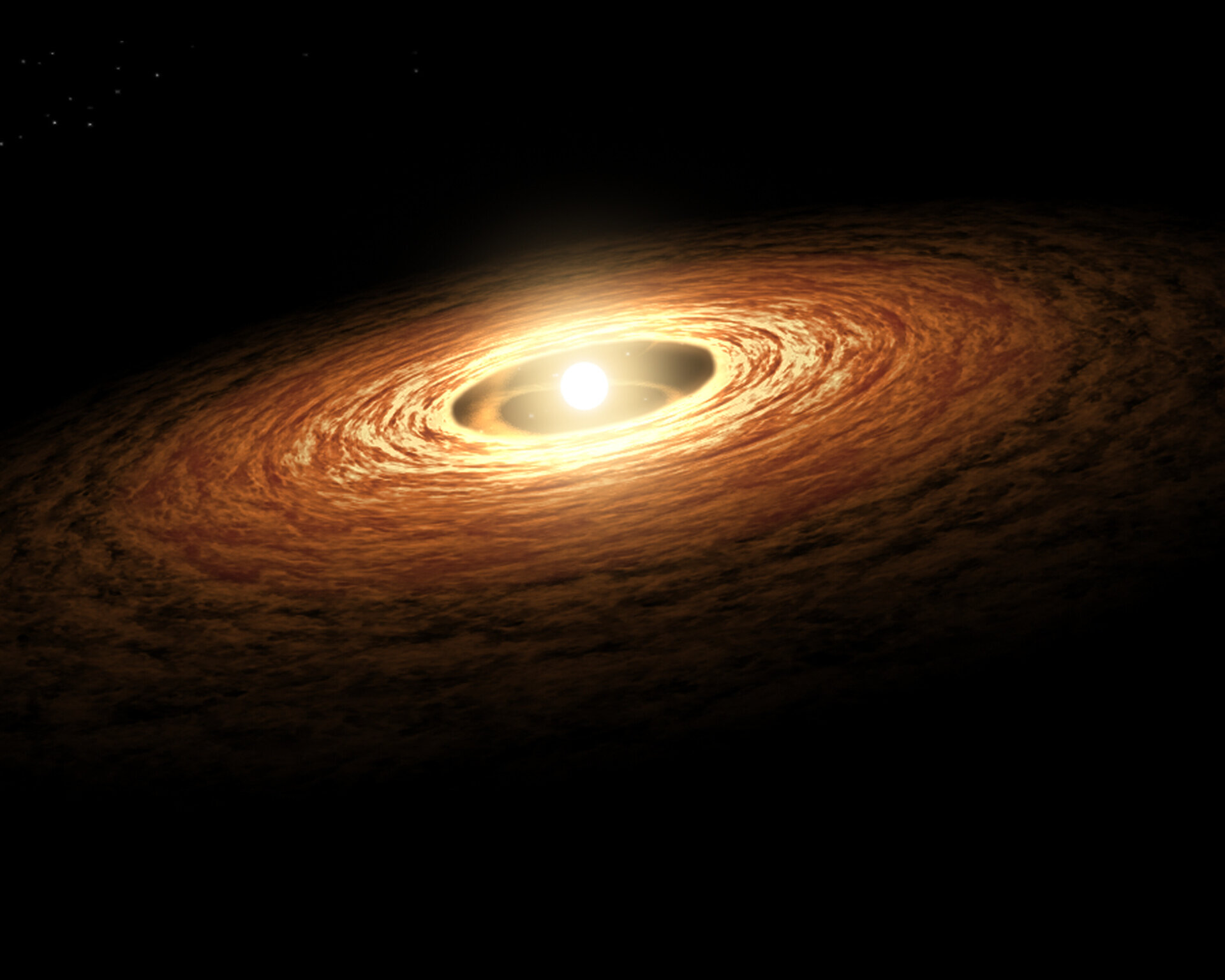Webb finds surprising ingredients around young star
An international team of astronomers have used the NASA/ESA/Webb James Webb Space Telescope to study the disc around a young and very low-mass star. The results reveal the richest hydrocarbon chemistry seen to date in a protoplanetary disc (including the first extrasolar detection of ethane) and contribute to our evolving understanding of the diversity of planetary systems.

Planets form in discs of gas and dust orbiting young stars. Observations indicate that terrestrial planets are expected to form more efficiently than gas giants in the discs around very low-mass stars. While very low-mass stars have the highest rate of occurrence of orbiting rocky planets, their planetary compositions are largely unknown. For example, the Trappist-1 system (which Webb has studied) consists of seven rocky planets within 0.1 AU [1] and their composition is generally assumed to be Earth-like. However, new data from Webb suggests that discs around very low-mass stars may evolve differently from those around more massive stars.
The MIRI Mid-INfrared Disk Survey (MINDS) aims to build a bridge between the chemical inventory of discs and the properties of exoplanets. In a new study, this team explored the region around a very low-mass star of 0.11 solar masses (known as ISO-ChaI 147). These observations provide insights into the environment as well as basic ingredients for such planets to form. The team found that the gas in the planet-forming region of the star is rich in carbon. This could potentially be because carbon is removed from the solid material from which rocky planets can form, and could explain why Earth is relatively carbon-poor.
“Webb has a better sensitivity and spectral resolution than previous infrared space telescopes,” explained lead author Aditya Arabhavi of the University of Groningen in the Netherlands. “These observations are not possible from Earth, because the emissions are blocked by the atmosphere. Previously we could only identify acetylene (C2H2) emission from this object. However, Webb’s higher sensitivity and spectral resolution allowed us to detect weak emission from less abundant molecules. Webb also allowed us to understand that these hydrocarbon molecules are not just diverse but also abundant.”

The spectrum revealed by Webb’s Mid-InfraRed Instrument (MIRI) shows the richest hydrocarbon chemistry seen to date in a protoplanetary disc, consisting of 13 carbon-bearing molecules up to benzene. This includes the first extrasolar detection of ethane (C2H6), the largest fully-saturated hydrocarbon [2] detected outside our Solar System. Since fully-saturated hydrocarbons are expected to form from more basic molecules, detecting them here gives researchers clues about the chemical environment. The team also successfully detected ethylene (C2H4), propyne (C3H4), and the methyl radical CH3, for the first time in a protoplanetary disc.
“These molecules have already been detected in our Solar System, for example in comets such as 67P/Churyumov–Gerasimenko and C/2014 Q2 (Lovejoy),” adds Aditya. “It is amazing that we can now see the dance of these molecules in the planetary cradles. It is a very different planet-forming environment from what we usually think of.”
The team indicates that these results have large implications for astrochemistry in the inner 0.1 AU and the planets forming there. “This is profoundly different from the composition we see in discs around solar-type stars, where oxygen bearing molecules dominate (like carbon dioxide and water),” added team member Inga Kamp, also of the University of Groningen. “This object establishes that these are a unique class of objects.”
“It’s incredible that we can detect and quantify the amount of molecules that we know well on Earth, such as benzene, in an object that is more than 600 light-years away,” added team member Agnés Perrin of Centre National de la Recherche Scientifique in France.
Next, the science team intend to expand their study to a larger sample of such discs around very low-mass stars to develop their understanding of how common such exotic carbon-rich terrestrial planet forming regions are. “The expansion of our study will also allow us to better understand how these molecules can form,” explained team member and PI of the MINDS programme, Thomas Henning, of the Max Planck Institute for Astronomy in Germany. “Several features in the Webb data are also still unidentified, so more spectroscopy is required to fully interpret our observations.”
This work also highlights the crucial need for scientists to collaborate across disciplines. The team notes that these results and the accompanying data can contribute towards other fields including theoretical physics, chemistry and astrochemistry, to interpret the spectra and to investigate new features in this wavelength range.
These results have been published in the journal Science.
Notes
[1] An astronomical unit (AU) is a unit of length effectively equal to the average, or mean, distance between Earth and the Sun, which is defined as roughly 150 million km.
[2] Saturated hydrocarbons are molecules that are made entirely of single carbon-carbon bonds. They cannot incorporate additional atoms into their structure, and are therefore said to be saturated.
More information
Webb is the largest, most powerful telescope ever launched into space. Under an international collaboration agreement, ESA provided the telescope’s launch service, using the Ariane 5 launch vehicle. Working with partners, ESA was responsible for the development and qualification of Ariane 5 adaptations for the Webb mission and for the procurement of the launch service by Arianespace. ESA also provided the workhorse spectrograph NIRSpec and 50% of the mid-infrared instrument MIRI, which was designed and built by a consortium of nationally funded European Institutes (The MIRI European Consortium) in partnership with JPL and the University of Arizona.
Webb is an international partnership between NASA, ESA and the Canadian Space Agency (CSA).
Contact:
ESA Media relations
media@esa.int















 Germany
Germany
 Austria
Austria
 Belgium
Belgium
 Denmark
Denmark
 Spain
Spain
 Estonia
Estonia
 Finland
Finland
 France
France
 Greece
Greece
 Hungary
Hungary
 Ireland
Ireland
 Italy
Italy
 Luxembourg
Luxembourg
 Norway
Norway
 The Netherlands
The Netherlands
 Poland
Poland
 Portugal
Portugal
 Czechia
Czechia
 Romania
Romania
 United Kingdom
United Kingdom
 Slovenia
Slovenia
 Sweden
Sweden
 Switzerland
Switzerland
























